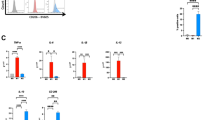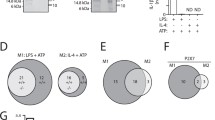Abstract
Macrophages’ phenotypic and functional diversity depends on differentiating programs related to local environmental factors. Recent interest was deserved to the signal transduction pathways acting in macrophage polarization, including the phosphoinositide (PI) system and related phospholipase C (PLC) family of enzymes. The expression panel of PLCs and the subcellular localization differs in quiescent cells compared to the pathological counterpart. We analyzed the expression of PLC enzymes in unpolarized (M0), as well as in M1 and M2 macrophages to list the expressed isoforms and their subcellular localization. Furthermore, we investigated whether inflammatory stimulation modified the basal panel of PLCs’ expression and subcellular localization. All PLC enzymes were detected within both M1 and M2 cells, but not in M0 cells. M0, as well as M1 and M2 cells own a specific panel of expression, different for both genes’ mRNA expression and intracellular localization of PLC enzymes. The panel of PLC genes’ expression and PLC proteins’ presence slightly changes after inflammatory stimulation. PLC enzymes might play a complex role in macrophages during inflammation and probably also during polarization.






Similar content being viewed by others
References
Aki D, Minoda Y, Yoshida H, Watanabe S, Yoshida R, Takaesu G, Chinen T, Inaba T, Hikida M, Kurosaki T, Saeki K, Yoshimura A (2008) Peptidoglycan and lipopolysaccharide activate PLCgamma2, leading to enhanced cytokine production in macrophages and dendritic cells. Genes Cells 13:199e208
Akira S, Misawa T, Satoh T, Saitoh T (2013) Macrophages control innate inflammation. Diabetes Obes Metab 15(s3):10–18
Benoit M, Desnues B, Mege JL (2008) Macrophage polarization in bacterial infections. J Immunol 181(6):3733–3739
Berridge MJ (1981) Phosphatidylinositol hydrolysis: amultifunctional transducing mechanism. Mol Cell Endocrinol 24(2):115–140
Berridge MJ (2009) Inositol trisphosphate and calcium signalling mechanisms. Biochim Biophys Acta 1793(6):933–940
Berridge MJ, Irvine RF (1984) Inositol triphosphate, a novel second messenger in cellular signal transduction. Nature 312:315–321
Beyer M, Mallmann MR, Xue J, Staratschek-Jox A, Vorholt D, Krebs W, Sommer D, Sander J, Mertens C, Nino-Castro A, Schmidt SV, Schultze JL (2012) High-resolution transcriptome of human macrophages. PLoS One 7(9), e45466
Botelho RJ, Teruel M, Dierckman R, Anderson R, Wells A, York JD, Meyer T, Grinstein S (2000) Localized biphasic changes in phosphatidylinositol-4,5-bisphosphate at sites of phagocytosis. J Cell Biol 151(7):1353–1368
Bunney TD, Katan M (2011) PLC regulation: emerging pictures for molecular mechanisms. Trends Biochem Sci 36(2):88–96
Calle Y, Burns S, Thrasher A, Jones G (2006) Eur J Cell Biol 85:151–157
Carman C, Sage P, Sciuto T, de la Fuente M, Geha R, Ochs H, Dvorak H, Dvorak A, Springer T (2007) Immunity 26:784–797
Chang ZL (2009) Recent development of the mononuclear phagocyte system: in memory of Metchnikoff and Ehrlich on the 100th Anniversary of the 1908 Nobel Prize in Physiology or Medicine. Biol Cell 101(12):709–721
Comer FI, Parent CA (2007) Phosphoinositides specify polarity during epithelial organ development. Cell 128(2):239–240
Daigneault M, Preston JA, Marriott HM, Whyte MK, Dockrell DH (2010) The identification of markers of macrophage differentiation in PMA-stimulated THP-1 cells and monocyte-derived macrophages. PLoS One 5(1), e8668. doi:10.1371/journal.pone.0008668
Evans J, Matsudaira P (2006) Eur J Cell Biol 85:145–149
Forbes SJ, Rosenthal N (2014) Preparing the ground for tissue regeneration: from mechanism to therapy. Nat Med 20:857–869
Gordon S (2007) The macrophage: past, present and future. Eur J Immunol 37(Suppl 1):S9–S17
Grinberg S, Hasko G, Wu D, Leibovich SJ (2009) Suppression of PLCbeta2 by endotoxin plays a role in the adenosine A(2A). receptor-mediated switch of macrophages from an inflammatory to an angiogenic phenotype. Am J Pathol 175(6):2439–2453
Holian A (1986) Leukotriene B4 stimulation of phosphatidylinositol turnover in macrophages and inhibition by pertussis toxin. FEBS Lett 201(1):15–19
Hwang JI, Oh YS, Shin KJ, Kim H, Ryu SH, Suh PG (2005) Molecular cloning and characterization of a novel phospholipase C, PLC ‐h. Biochem J 389:181–186
Kanemaru K, Nakamura Y, Sato K, Kojima R, Takahashi S, Yamaguchi M, Ichinohe M, Kiyonari H, Shioi G, Kabashima K, Nakahigashi K, Asagiri M, Jamora C, Yamaguchi H, Fukami K. (2012) Epidermal phospholipase Cδ 1 regulates granulocyte counts and systemic interleukin-17 levels in mice. Nat Commun 17(3):963
Kim JK, Choi JW, Lim S, Kwon O, Seo JK, Ryu SH, Suh PG (2011) Phospholipase C‐h1 is activated by intracellular Ca2 mobilization and enhances GPCRs/PLC/Ca2 signaling. Cell Signal 23:1022–1029
Liu DZ, Liang HJ, Chen CH, Lin SY, Zhong WB, Ho FM, Hou WC, Lo JL, Ho YS, Lin PJ, Hung LF, Liang YC (2007) Switch activation of PI-PLC downstream signals in activated macrophages with wortmannin. Biochim Biophys Acta 1773(6):869–879
Lo Vasco VR, Fabrizi C, Artico M, Cocco L, Billi AM, Fumagalli L, Manzoli FA (2007) Expression of phosphoinositide-specific phospholipase C isoenzymes in cultured astrocytes. J Cell Biochem 100(4):952–959
Lo Vasco VR, Fabrizi C, Panetta B, Fumagalli L, Cocco L (2010a) Expression pattern and sub cellular distribution of Phosphoinositide specific Phospholipase C enzymes after treatment with U-73122 in rat astrocytoma cells. J Cell Biochem 110(4):1005–1012
Lo Vasco VR, Fabrizi C, Fumagalli L, Cocco L (2010b) Expression of phosphoinositide specific phospholipase C isoenzymes in cultured astrocytes activated after stimulation with Lipopolysaccharide. J Cell Biochem 109(5):1006–1012
Lo Vasco VR, Leopizzi M, Chiappetta C, Puggioni C, Della Rocca C, Businaro R (2013) Lypopolysaccharide down-regulates the expression of selected phospholipase C genes in cultured endothelial cells. Inflammation 36(4):862–868
Lo Vasco VR, Leopizzi M, Puggioni C, Della Rocca CI, Businaro R (2014a) Neuropeptide Y significantly reduces the expression of PLCB2, PLCD1 and moderately decreases selected PLC genes in endothelial cells. Mol Cell Biochem 394(1-2):43–52
Lo Vasco VR, Leopizzi M, Puggioni C, Della Rocca C (2014b) Ezrin silencing remodulates the expression of Phosphoinositide-specific Phospholipase C enzymes in human osteosarcoma cell lines. J Cell Commun Signal 8(3):219–229
Lo Vasco VR, Leopizzi M, Stoppoloni D, Della Rocca C (2014c) Silencing of phosphoinositide-specific phospholipase C ε remodulates the expression of the phosphoinositide signal transduction pathway in human osteosarcoma cell lines. Anticancer Res 34(8):4069–4075
Lo Vasco VR, Leopizzi M, Puggioni C, Della Rocca C, Businaro R (2014d) Fibroblast growth factor acts upon the transcription of phospholipase C genes in human umbilical vein endothelial cells. Mol Cell Biochem 388(1):51–59
Lo Vasco VR, Leopizzi M, Della Rocca C (2015) Ezrin-related Phosphoinositide pathway modifies RhoA and Rac1 in human osteosarcoma cell lines. J Cell Commun Signal 9(1):55–62
Mantovani A, Sozzani S, Locati M, Allavena P, Sica A (2002) Macrophage polarization: tumor-associated macrophages as a paradigm for polarized M2 mononuclear phagocytes. Trends Immunol 23(11):549–555
Martinez FO, Gordon S (2014) The M1 and M2 paradigm of macrophage activation: time for reassessment. F1000Prime Reports 6, article 13
Martinez FO, Gordon S (2014) The M1 and M2 paradigm of macrophage activation: time for reassessment. F1000prime reports 6:13
Martinez FO, Gordon S, Locati M, Mantovani A (2006) Transcriptional profiling of the human monocyte-to-macrophage differentiation and polarization: new molecules and patterns of gene expression. J Immunol 177(10):7303–7311
Miyauchi A, Hruska K, Greenfield E, Duncan R, Alvarez J, Barattolo R, Colucci S, Zambonin-Zallone A, Teitelbaum S, Teti A (1990) J Cell Biol 111:2543–2552
Mosser DM, Edwards JP (2008) Exploring the full spectrum of macrophage activation. Nat Rev Immunol 8:958–969
Nakahara M, Shimozawa M, Nakamura Y, Irino Y, Morita M, Kudo Y, Fukami K (2005) A novel phospholipase C, PLCh2, is a neuron‐specific isozyme. J Biol Chem 280:29128–29134
Osborn O, Olefsky JM (2012) The cellular and signaling networks linking the immune system and metabolism in disease. Nat Med 18(3):363–374
Pollard JW (2009) Trophic macrophages in development and disease. Nat Rev Immunol 9(4):259–270
Popovics P, Beswick W, Guild SB, Cramb G, Morgan K, Millar RP, Stewart AJ (2011) Phospholipase C‐h2 is activated by elevated intracellular Ca2 levels. Cell Signal 23:1777–1784
Popovics P, Lu J, Nadia Kamil L, Morgan K, Millar RP, Schmid R, Blindauer CA, Stewart AJ (2014) A canonical EF-loop directs Ca(2+). -sensitivity in phospholipase C-η2. J Cell Biochem 115(3):557–565
Rhee SG, Kim H, Suh PG, Choi WC (1991) Multiple forms of phosphoinositide-specific phospholipase C and different modes of activation. Biochem Soc Trans 19(2):337–41
Rőszer T (2015) Understanding the mysterious M2 macrophage through activation markers and effector mechanisms. Mediat Inflamm 2015:816460
Sica A, Mantovani A (2012) Macrophage plasticity and polarization: in vivo veritas. J Clin Invest 122(3):787–795
Stewart AJ, Mukherjee J, Roberts SJ, Lester D, Farquharson C (2005) Identification of a novel class of mammalian phosphoinositol‐specific phospholipase C enzymes. Int J Mol Med 15:117–121
Suh PG, Park J, Manzoli L, Cocco L, Peak JC, Katan M, Fukami K, Kataoka T, Yuk S, Ryu SH (2008) Multiple roles of phosphoinositide-specific phospholipase C isozymes. BMB Rep 41:415–434
Tang CH, Yang RS, Fu WM (2005) Prostaglandin E2 stimulates fibronectin expression through EP1 receptor, phospholipase C, protein kinase Calpha, and c-Src pathway in primary cultured rat osteoblasts. J Biol Chem 280(24):22907–22916
Tsuboi S (2007) J Immunol 178:2987–2995
Tuosto L, Capuano C, Muscolini M, Santoni A, Galandrini R (2015) The multifaceted role of PIP2 in leukocyte biology. Cell Mol Life Sci 72(23):4461–4474
Zhang F, Liu H, Jiang G, Wang H, Wang X, Wang H, Fang R, Cai S, Du J (2015) Changes in the proteomic profile during the differential polarization status of the human monocyte-derived macrophage THP-1 cell line. Proteomics 15(4):773–786
Zhao S, Liao H, Ao M, Wu L, Zhang X, Chen Y (2014) Fixation-induced cell blebbing on spread cells inversely correlates with phosphatidylinositol 4,5-bisphosphatelevel in the plasma membrane. FEBS Open Biol 4:190–199
Zhou Y, Wing MR, Sondek J, Harden TK (2005) Molecular cloning and characterization of PLC-eta2. Biochem J 1;391(Pt 3):667–76
Author information
Authors and Affiliations
Corresponding author
Additional information
Tania Di Raimo and Martina Leopizzi contributed equally to this work.
Rights and permissions
About this article
Cite this article
Di Raimo, T., Leopizzi, M., Mangino, G. et al. Different expression and subcellular localization of Phosphoinositide-specific Phospholipase C enzymes in differently polarized macrophages. J. Cell Commun. Signal. 10, 283–293 (2016). https://doi.org/10.1007/s12079-016-0335-9
Received:
Accepted:
Published:
Issue Date:
DOI: https://doi.org/10.1007/s12079-016-0335-9




